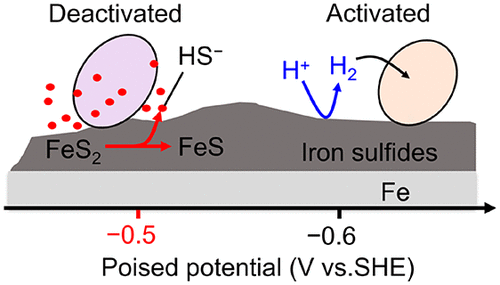当前位置:
X-MOL 学术
›
Environ. Sci. Technol. Lett.
›
论文详情
Our official English website, www.x-mol.net, welcomes your feedback! (Note: you will need to create a separate account there.)
Mechanism of Anaerobic Microbial Corrosion Suppression by Mild Negative Cathodic Polarization on Carbon Steel
Environmental Science & Technology Letters ( IF 10.9 ) Pub Date : 2020-07-15 , DOI: 10.1021/acs.estlett.0c00383 Marina Shiibashi 1 , Xiao Deng 2 , Waheed Miran 3 , Akihiro Okamoto 3, 4
Environmental Science & Technology Letters ( IF 10.9 ) Pub Date : 2020-07-15 , DOI: 10.1021/acs.estlett.0c00383 Marina Shiibashi 1 , Xiao Deng 2 , Waheed Miran 3 , Akihiro Okamoto 3, 4
Affiliation

|
Microbially influenced corrosion (MIC) in anaerobic environments has serious negative impacts on the industry and economy. While cathodic polarization (CP) has been widely used to inhibit abiotic corrosion, its potential applicability on MIC has been scarcely elucidated. Here, we report high MIC suppression by CP and its potential mechanism on a carbon steel electrode with Desulfovibrio vulgaris Hildenborough, a model sulfate-reducing bacterium for MIC. Following MIC associated with FeS2 formation on carbon steel, we initiated CP at −0.5 V (vs the standard hydrogen electrode) for 12 h, which consumed low electricity but resulted in a >80% reduction in the corrosion current for at least 1 week. X-ray photoelectron spectroscopy and transcriptome analyses showed the reduction of FeS2 to FeS and downregulated cell metabolism, respectively, thus suggesting that HS–, produced via the electrochemical reduction of FeS2, deactivated D. vulgaris at −0.5 V. Accordingly, a weaker impact was observed at positive potentials of −0.3 and −0.4 V that scarcely reduced FeS2, and at negative potentials of −0.6 and −0.7 V that reduced FeS2, but produced hydrogen that promotes the growth of D. vulgaris. This potential mechanism suggests the broad applicability of mild negative CP to suppress MIC in an environmentally friendly and cost-effective manner.
中文翻译:

碳钢温和负阴极极化抑制厌氧微生物腐蚀的机理
厌氧环境中受微生物影响的腐蚀(MIC)对工业和经济产生严重的负面影响。尽管阴极极化(CP)已被广泛用于抑制非生物腐蚀,但几乎没有阐明其在MIC上的潜在适用性。在这里,我们报道了由CP抑制硫酸盐还原的典型细菌Desulfovibrio vulgaris Hildenborough在碳钢电极上受CP抑制的高MIC及其潜在机理。MIC与碳钢上的FeS 2形成相关联后,我们在-0.5 V(相对于标准氢电极)上启动了CP 12小时,这消耗了低电量,但导致腐蚀电流降低了> 80%,至少持续了1周。X射线光电子能谱和转录组分析表明FeS的减少2分别对FeS和下调的细胞代谢,因此表明,通过电化学还原FeS 2产生的HS –使-0.5 V下的普通D.灭活。因此,在-0.3和-0.4的正电势下观察到的影响较弱V几乎不会还原FeS 2,在-0.6和-0.7的负电位下会还原FeS 2,但会产生氢,从而促进寻常藻的生长。这种潜在的机制表明,轻度负性CP具有广泛的适用性,可以以环保和经济的方式抑制MIC。
更新日期:2020-09-08
中文翻译:

碳钢温和负阴极极化抑制厌氧微生物腐蚀的机理
厌氧环境中受微生物影响的腐蚀(MIC)对工业和经济产生严重的负面影响。尽管阴极极化(CP)已被广泛用于抑制非生物腐蚀,但几乎没有阐明其在MIC上的潜在适用性。在这里,我们报道了由CP抑制硫酸盐还原的典型细菌Desulfovibrio vulgaris Hildenborough在碳钢电极上受CP抑制的高MIC及其潜在机理。MIC与碳钢上的FeS 2形成相关联后,我们在-0.5 V(相对于标准氢电极)上启动了CP 12小时,这消耗了低电量,但导致腐蚀电流降低了> 80%,至少持续了1周。X射线光电子能谱和转录组分析表明FeS的减少2分别对FeS和下调的细胞代谢,因此表明,通过电化学还原FeS 2产生的HS –使-0.5 V下的普通D.灭活。因此,在-0.3和-0.4的正电势下观察到的影响较弱V几乎不会还原FeS 2,在-0.6和-0.7的负电位下会还原FeS 2,但会产生氢,从而促进寻常藻的生长。这种潜在的机制表明,轻度负性CP具有广泛的适用性,可以以环保和经济的方式抑制MIC。



























 京公网安备 11010802027423号
京公网安备 11010802027423号